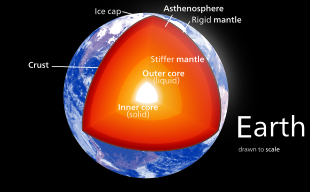
The lower mantle, historically also known as the mesosphere, represents approximately 56% of Earth's total volume, and is the region from 660 to 2900 km below Earth's surface; between the transition zone and the outer core.[1] The preliminary reference Earth model (PREM) separates the lower mantle into three sections, the uppermost (660–770 km), mid-lower mantle (770–2700 km), and the D layer (2700–2900 km).[2] Pressure and temperature in the lower mantle range from 24–127 GPa[2] and 1900–2600 K.[3] It has been proposed that the composition of the lower mantle is pyrolitic,[4] containing three major phases of bridgmanite, ferropericlase, and calcium-silicate perovskite. The high pressure in the lower mantle has been shown to induce a spin transition of iron-bearing bridgmanite and ferropericlase,[5] which may affect both mantle plume dynamics[6][7] and lower mantle chemistry.[5]
The upper boundary is defined by the sharp increase in seismic wave velocities and density at a depth of 660 kilometers (410 mi).[8] At a depth of 660 km, ringwoodite (γ-(Mg,Fe)
2SiO
4) decomposes into Mg-Si perovskite and magnesiowüstite.[8] This reaction marks the boundary between the upper mantle and lower mantle. This measurement is estimated from seismic data and high-pressure laboratory experiments. The base of the mesosphere includes the D″ zone which lies just above the mantle–core boundary at approximately 2,700 to 2,890 km (1,678 to 1,796 mi). The base of the lower mantle is about 2700 km.[8]
- ^ Kaminsky, Felix V. (2017). The Earth's lower mantle: composition and structure. Cham: Springer. ISBN 9783319556840. OCLC 988167555.
- ^ a b Dziewonski, Adam M.; Anderson, Don L. (1981). "Preliminary reference Earth model". Physics of the Earth and Planetary Interiors. 25 (4): 297–356. Bibcode:1981PEPI...25..297D. doi:10.1016/0031-9201(81)90046-7. ISSN 0031-9201.
- ^ Cite error: The named reference
:3was invoked but never defined (see the help page). - ^ Ringwood, Alfred E. (1976). Composition and petrology of the earth's mantle. McGraw-Hill. ISBN 0070529329. OCLC 16375050.
- ^ a b Badro, J. (2003-04-03). "Iron Partitioning in Earth's Mantle: Toward a Deep Lower Mantle Discontinuity". Science. 300 (5620): 789–791. Bibcode:2003Sci...300..789B. doi:10.1126/science.1081311. ISSN 0036-8075. PMID 12677070. S2CID 12208090.
- ^ Shahnas, M.H.; Pysklywec, R.N.; Justo, J.F.; Yuen, D.A. (2017-05-09). "Spin transition-induced anomalies in the lower mantle: implications for mid-mantle partial layering". Geophysical Journal International. 210 (2): 765–773. doi:10.1093/gji/ggx198. ISSN 0956-540X.
- ^ Bower, Dan J.; Gurnis, Michael; Jackson, Jennifer M.; Sturhahn, Wolfgang (2009-05-28). "Enhanced convection and fast plumes in the lower mantle induced by the spin transition in ferropericlase". Geophysical Research Letters. 36 (10). Bibcode:2009GeoRL..3610306B. doi:10.1029/2009GL037706. ISSN 0094-8276.
- ^ a b c Condie, Kent C. (2001). 'Mantle Plumes and Their Record in Earth History. Cambridge University Press. pp. 3–10. ISBN 0-521-01472-7.
© MMXXIII Rich X Search. We shall prevail. All rights reserved. Rich X Search
